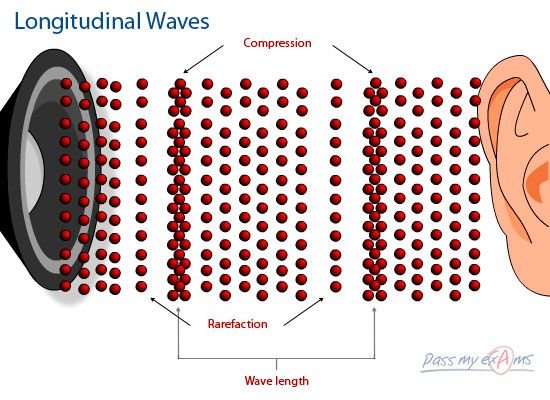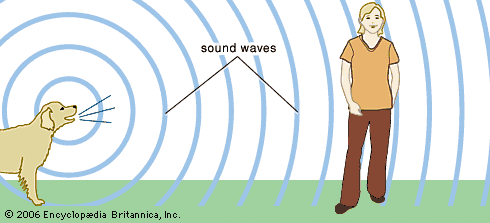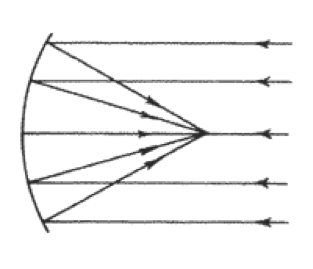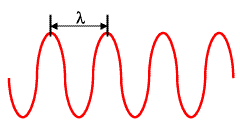What is Sound and How Does It Travel?
What is Sound and How Does It Travel?
Sound is the movement of energy in the form of vibrations, which moves in longitudinal waves through substances such as air, solids, and liquids.
*A wave is a disturbance of a medium (air, solid, Liquid) which propagates energy through the medium without permanently transporting the matter. *
A longitudinal wave is where the particles of the medium oscillate backward and forwards instead of traveling with the wave.
This has been illustrated in the diagram below:
The particles that are being propagated from the speaker to the person's ear have been represented by the red dots. Observing the diagram one may have noticed that the particles have formed some kind of a pattern.
The particles that are spaced apart are known as the “Rarefactions” and the particles that are close together are known as the “Compressions”. This is an example of the way that sound travels.
In regards to the diagram above the compressions are caused by the cone of the speaker. As the speaker cone vibrates it essentially pushes the particles that are closest to the speaker outwards into the particles that next in line from the speaker, The contact of these particles are what's known as the compressions. Once the particles have pushed the following particles outwards they then proceed to move back to their original position, This is what is known as the rarefactions.
It is important to understand that sound doesn't travel directly from the source to your ears but instead travels outwards from the source whilst penetrating and bouncing off of many different surfaces. This is how the sound reaches your ears even if there is an object standing between you and the source.
This diagram is a very simplified demonstration on the direction that all sounds travel In, no matter what frequencies they contain.
There are many points that need to be taken into account when measuring which direction a sound is traveling in. The illustrator of the picture above hasn’t actually taken into account the reflections that will occur once the sound waves hit a surface (Such as the man). These reflections depending on the shape of the surface that the sound is reflecting off may then double back and result in some of the frequencies within the wave canceling out; for example, if the sound wave were to hit a convexed surface then it would undoubtedly reflect off in multiple directions; as demonstrated by the following diagram:
whereas, If the soundwave were to hit a concave surface then the soundwave would reflect in the direction that the surface is facing in, like so;
Now, referring back to the diagram of the barking dog. Would the sound wave really form a perfect circle around the source? As you can see the dog is barking in a specific direction. This means that If you were to measure how long it would take for the sound to reach one metre from the source from every direction possible, Then it would take slightly longer for the sound to reach one metre behind the dog than it would 1 metre in front of it. This means that the doggo diagram although helpful is also very inaccurate.
One should also take into consideration the frequency of a sound when measuring how it travels. Bass frequencies for example; or anything below 200 Hz are known to be omnidirectional, This is why at large music events such as festivals or in clubs, There are usually far fewer subwoofers than there are speakers and in many cases, there is only one. This is because. bass frequencies would have a noticeable phasing effect, due to multiple waveforms canceling each other out.
As it more common for there to be only one sub in a venue, any frequencies below 200Hz may take a longer time to reach your ears than that of the higher frequencies that are coming from multiple speakers; this can make it very difficult to pinpoint where the sound is actually coming from as the sound waves would have bounced of off multiple surfaces before reaching your ears.
The length of a frequency is determined by how far the sound has traveled before the sound wave has completed a full cycle.
The full cycle has been measured from the first peak of the sound wave to the second peak. This is what is meant by a “Full Cycle”
Unlike bass frequencies, higher frequencies are normally more directional; As they are unlikely to travel as far due to the size of the wavelength, this means that by the time the higher frequencies have reflected from a surface and reached your ears, they have died away to an almost inaudible level.
If you were to attend a large music event, then you would likely notice that there is an abundance of mid-range speakers/tweeters placed all around the venue, This is to ensure that the higher frequencies reach as much of the space in the venue as possible.
If you were to place too few speakers around a large audience then you would begin to notice a large number of audible blind spots throughout the venue. There would even be certain spots within the crowd where none of the higher frequencies could be heard at all.
Finally, we have “Loudness”.
Loudness is measured using the decibel scale and is mostly based on human perception. The way in which we measure loudness is by measuring the sound pressure levels or SPL’s.
SPLs are the result of variations in air pressure, which is caused by sound waves.
The average range of SPLs that is audible by the human ear range from 20 μPa, which is known as the average hearing threshold to 20 Pa, known as the pain Threshold. Since using these measurements are seen to be quite impractical, Decibels were introduced by Alexander Graham Bell back in 1928.
,
It’s very easy for the average person to take sound for granted, not only can be used to create musical masterpieces for the ear or as a means of communication amongst many living beings, but it can also be a very powerful force.
Now, I don’t plan on going any further into this subject in this post, but I will leave you with a couple of articles that may take your interest.
,
The first one is about LRAD, which is essentially a sound cannon that is used by the military as a means to control large crowds of people.
http://science.howstuffworks.com/lrad.htm
The second is about how sound, If loud enough could disintegrate every organ in the human body.
http://www.popsci.com/technology/article/2012-11/acoustic-weapons-book-excerpt
As of now steemit, I’m CVRTL, And Thanks for Reading.
Sources and other stuff:
http://www.physicsclassroom.com/mmedia/waves/lw.cfm
http://www.acs.psu.edu/drussell/Demos/rad2/mdq.html
http://www.acs.psu.edu/drussell/Demos/waves/wavemotion.html
http://arstechnica.com/civis/viewtopic.php?f=6&t=437545
www.ecophon.com/uk/...bank/...sound.../Sound-pressure-and-decibels/
http://www.acousticalsurfaces.com/acoustic_IOI/101_3.htm
http://www.twi-global.com/technical-knowledge/faqs/ndt/faq-what-are-the-main-properties-of-a-sound-wave-relevant-to-ultrasonic-testing/
http://www.youredm.com/






great and interesting post upvote and follow ! im a lover of this thing called sound ;)